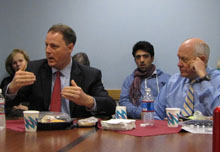
October 27, 2009 — Politico editor-in-chief, John Harris, spoke at the Shorenstein Center’s brown-bag lunch about “Barack Obama vs. the Freak Show: Politics and Media on the Wild Frontier.”
Harris, a veteran of The Washington Post who founded Politico in 2007 together with Jim VandeHei, traced the shift from what he called the “old order” to today’s racous media environment. Before, there were a “handful of elite institutions that largely set the filter” for what was considered news in politics and government.” While the old order had its problems, Harris noted, it sought to find “common facts.” But technological changes have “demolished the idea of a filter … and common standards of relevance.”
The “freak show,” as described by Harris, is the trend in politics to be “divisive, rancorous, prone to extremes.” While “contemptuous of the trend,” he sees politics changing into a “business of polarization, [where] there are deep incentives within political and media culture that reward extreme behavior and … create a marketplace for political division, for polarization.” This business has become profitable, as well as “more extreme, more rude, less civil.” The key figures in the freak show, Harris says, recognize that “it’s a way to get good ratings.”
Turning to media’s influence on politics, Harris said that “in an era of freak-show politics and freak-show media, the biggest challenge that any politician has is controlling his or her public image, which can be destroyed in an instant.” Obama, with his strategy of unifying the country and transcending politics, has not lost control of his public image, said Harris, but the threat is there, and President Obama “is singularly vulnerable to these forces.”
Harris concluded with his concern that “we all live in individual echo chambers,” but “that is not our obligation as citizens. It’s to come to the middle and argue around a common set of facts.”
This article was written by Janell Sims and the photos taken by Leighton Walter Kille, both of the Shorenstein Center.

